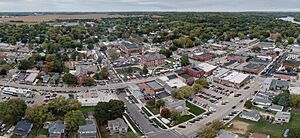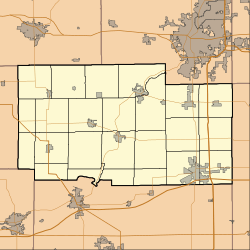Oregon, Illinois facts for kids
Quick facts for kids
Oregon
|
||
|---|---|---|

Downtown Oregon, IL
|
||
|
||
| Motto(s):
Gem of the Rock River Valley
|
||

Location of Oregon in Ogle County, Illinois.
|
||
| Country | United States | |
| State | Illinois | |
| County | Ogle | |
| Township | Oregon-Nashua | |
| Founded | 1833 | |
| Area | ||
| • Total | 2.00 sq mi (5.17 km2) | |
| • Land | 1.93 sq mi (4.99 km2) | |
| • Water | 0.07 sq mi (0.18 km2) | |
| Elevation | 709 ft (216 m) | |
| Population
(2020)
|
||
| • Total | 3,604 | |
| • Density | 1,870.26/sq mi (722.10/km2) | |
| Time zone | UTC−6 (CST) | |
| • Summer (DST) | UTC−5 (CDT) | |
| Postal code |
61061
|
|
| Area code(s) | 815 | |
| FIPS code | 17-56484 | |
Oregon is a city in Ogle County, Illinois, United States. It is also the county seat, which means it's where the main government offices for the county are located. In 2010, about 3,721 people lived here.
Contents
History of Oregon, Illinois
The land where Oregon, Illinois, now stands was once home to the Potawatomi and Winnebago Native American tribes. Early settlers found many ancient Indian mounds in the area. These mounds were usually about 10 to 12 feet (3 to 3.7 meters) across.
Early Settlers and Founding
The first European visitor to this land was a pioneer named John Phelps. He came in 1829 and returned in 1833. Phelps was looking for a good place to settle down. He found a beautiful valley with forests and a river, which he liked very much. So, he built his cabin there.
Other pioneers soon followed Phelps to this spot. Phelps helped start the first church, school, grocery store, and post office in Oregon. By December 4, 1838, the land was officially claimed and divided. It was then named Oregon City. The name "Oregon" means "River of the West."
Name Changes and Growth
In 1839, Oregon City was renamed Florence. A visitor thought the Rock River area looked as beautiful as the city of Florence in Italy. However, the name Florence only lasted about three years. In 1843, the city decided to go back to its original name, but without the word "city." So, it became just Oregon.
By 1847, Oregon had a general store, a sawmill, and a ferry. About 225 people lived in 44 households. The town continued to grow in the 1850s and 1860s. More churches were built, and a railroad arrived in 1871.
Industry and Government
The railroad brought new industries to Oregon. The city became home to an oatmeal mill, a furniture factory, and a chair factory. There was also a flour mill and a metal factory called Paragon Foundry. This foundry operated until the 1960s.
The city of Oregon was officially set up by the Illinois General Assembly on April 1, 1869. By the 1870s, about 2,000 people lived in Oregon and the nearby area. James Gale was elected as the city's first mayor on March 21, 1870. Four other men were chosen as aldermen, who are like city council members.
In 1873, the city was reorganized under a new state law. This law allowed towns to become official cities or villages. The Oregon City Hall was built in 1920. It has been the center of city government ever since. The Ogle County Courthouse was built in 1891.
Famous Statue
Between 1908 and 1911, a famous sculptor named Lorado Taft created a large statue. It is 50 feet (15 meters) tall and stands on a bluff overlooking the Rock River valley. Taft first called it The Eternal Indian. Today, it is known as the Black Hawk Statue. It is named after Black Hawk, a chief of the Sauk Indian tribe. This tribe once lived in the area.
In 1993, the city of Oregon grew bigger by adding the nearby area of Daysville, Illinois.
Geography of Oregon
Oregon covers a total area of about 2.028 square miles (5.25 square kilometers). Most of this area, about 1.96 square miles (5.08 square kilometers), is land. The rest, about 0.068 square miles (0.18 square kilometers), is water.
Population of Oregon
| Historical population | |||
|---|---|---|---|
| Census | Pop. | %± | |
| 1880 | 1,088 | — | |
| 1890 | 1,566 | 43.9% | |
| 1900 | 1,577 | 0.7% | |
| 1910 | 2,180 | 38.2% | |
| 1920 | 2,227 | 2.2% | |
| 1930 | 2,376 | 6.7% | |
| 1940 | 2,825 | 18.9% | |
| 1950 | 3,205 | 13.5% | |
| 1960 | 3,732 | 16.4% | |
| 1970 | 3,539 | −5.2% | |
| 1980 | 3,559 | 0.6% | |
| 1990 | 3,891 | 9.3% | |
| 2000 | 4,060 | 4.3% | |
| 2010 | 3,721 | −8.3% | |
| 2020 | 3,604 | −3.1% | |
| U.S. Decennial Census | |||
As of the census in 2010, Oregon had 3,721 residents. There were 1,630 households in the city. The population density was about 1,998.5 people per square mile (771.6 people per square kilometer).
Most of the people living in Oregon are White (95.9%). Other groups include African American (0.9%), Asian (0.8%), and Native American (0.1%). About 4.2% of the population identified as Hispanic or Latino.
The average household had 2.18 people. The average family had 2.83 people. The median age in the city was 43.5 years old.
Culture and Arts in Oregon
Oregon has a strong connection to the arts. In February 2021, plans were made to renovate the historic Oregon Coliseum. This building will become a new museum and cultural center.
The community also hosts several big events each year. These include the "Autumn On Parade," "Candlelight Walk," and "ShamROCK The Town."
The Eagle's Nest Art Colony
In 1898, the sculptor Lorado Taft started the Eagle's Nest Art Colony. It was located on a bluff overlooking the Rock River, just north of Oregon. Taft and his art colony had a big impact on the city's culture.
The artists who spent their summers at Eagle's Nest influenced the town below. For example, when the Oregon Public Library was built in 1908, it included a second-story art gallery. Artists from the colony had to contribute to the local culture. They did this by holding art shows, giving lectures, and putting on plays.
In 1904, Taft created a sculpture called The Blind. He then started working on larger sculptures. One of these was The Eternal Indian, which is located north of Oregon in Lowden State Park. Other works by Taft can be found in and around Oregon. This includes The Soldiers' Monument on the courthouse lawn.
Notable People from Oregon
Many interesting people have connections to Oregon:
- Norene Arnold, a player in the All-American Girls Professional Baseball League.
- Neva Burright, a harness racing driver. She was the first woman to win a Grand Circuit race.
- James H. Cartwright, who served as a justice on the Illinois Supreme Court.
- Sherman Landers, an Olympic triple jumper in the 1920 Summer Olympics.
- Frank Loomis, an Olympic gold medalist and world record holder in the 400m hurdles at the 1920 Summer Olympics.
- Frank Orren Lowden, the 25th Governor of Illinois. He owned an estate near Oregon.
- Fred Roat, a baseball player for the Pittsburgh Alleghenys and Chicago Colts.
- Lorado Taft, a famous sculptor.
See also
In Spanish: Oregón (Illinois) para niños




